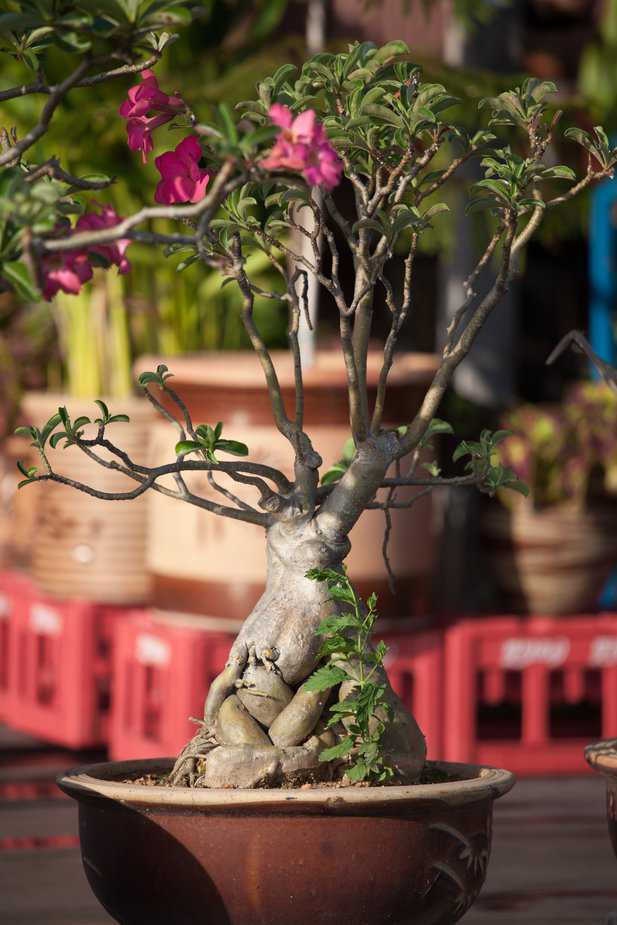The desert rose plant (Adenium obesum) is a popular succulent plant that belongs to the family Apocynaceae. It is known for its beautiful flowers and attractive, swollen base that is used for storing water. The plant is native to the arid regions of East Africa and the Arabian Peninsula, where it thrives in hot and dry conditions. In this article, we will discuss how to take care of the desert rose plant and ensure it remains healthy and thriving.
Watering
The desert rose plant is adapted to arid conditions and can survive long periods without water. However, it still requires regular watering, especially during the growing season. The frequency of watering depends on several factors, including the size of the pot, the size of the plant, and the prevailing weather conditions. As a rule of thumb, you should water your desert rose plant when the soil feels dry to the touch.
To water the plant, use a watering can or a hose with a gentle spray nozzle. Avoid overwatering the plant as this can lead to root rot and other diseases. Also, avoid getting water on the leaves and flowers, as this can cause fungal diseases.
Light
The desert rose plant requires bright, direct sunlight to thrive. It can tolerate some shade, but prolonged periods of low light can cause the plant to become leggy and weak. If you are growing your plant indoors, place it near a south-facing window where it can receive at least six hours of direct sunlight per day. If you are growing your plant outdoors, choose a spot that receives full sun for most of the day.
Soil
The desert rose plant requires well-draining soil that is rich in organic matter. A good soil mix for desert rose plants should be made up of equal parts of sand, perlite, and potting soil. You can also add some compost or vermiculite to the mix to improve its water-holding capacity.
When planting your desert rose plant, make sure the soil level is at the same height as the base of the stem. This will prevent the plant from developing stem rot, which can be caused by excessive moisture in the soil.
Fertilizer
The desert rose plant requires regular fertilization to promote healthy growth and flowering. You can use a balanced fertilizer with equal amounts of nitrogen, phosphorus, and potassium, or a specialized fertilizer that is formulated for succulent plants. Apply the fertilizer every two weeks during the growing season, which typically runs from late spring to early fall.
Be careful not to over-fertilize the plant, as this can lead to salt buildup in the soil and cause the roots to burn. Follow the manufacturer’s instructions for the correct dosage and application method.
Pruning
Pruning is an essential part of desert rose plant care as it helps to maintain the plant’s shape and size and promotes healthy growth. You should prune your plant regularly, especially during the growing season, to remove dead or damaged branches, promote branching, and stimulate new growth.
To prune your desert rose plant, use a sharp, sterile pair of scissors or pruning shears. Make clean cuts just above a leaf or bud, and avoid cutting too close to the main stem, as this can cause damage. You can also pinch back the growing tips of the plant to encourage branching and produce a fuller, more compact plant.
Repotting
The desert rose plant requires repotting every two to three years to provide it with fresh soil and space for root growth. You should choose a pot that is slightly larger than the current one and has drainage holes at the bottom.
When repotting your plant, gently remove it from its current pot and loosen the soil around the roots. Trim any dead or damaged roots, and
place the plant in the new pot, making sure the soil level is at the same height as the base of the stem. Add fresh soil mix around the roots, pressing it down lightly to remove any air pockets.
Water the plant thoroughly after repotting, and avoid fertilizing it for at least a month to give the plant time to adjust to its new environment. Keep the plant out of direct sunlight for a few days to prevent it from becoming stressed.
Pests and Diseases
The desert rose plant is generally resistant to pests and diseases, but it can still be affected by a few common problems. Some of the most common pests that can attack the plant include spider mites, mealybugs, and scale insects. These pests can be controlled by washing the plant with a mild soap solution or by using an insecticidal spray.
The plant can also be affected by fungal diseases, such as root rot, powdery mildew, and black spot. These diseases are usually caused by overwatering or poor air circulation. To prevent fungal diseases, avoid getting water on the leaves and flowers, and make sure the plant has good air circulation.
Winter Care
During the winter months, the desert rose plant enters a period of dormancy and requires less water and fertilizer. You should reduce the frequency of watering to once every two to three weeks, and stop fertilizing the plant altogether.
If you are growing your plant outdoors, you should protect it from frost and freezing temperatures by covering it with a frost blanket or moving it indoors. If you are growing your plant indoors, you should place it near a window where it can receive ample sunlight.
Propagation
The desert rose plant can be propagated by stem cuttings or by seeds. Stem cuttings should be taken during the growing season and should be about 6 inches long. Remove the lower leaves from the stem, leaving only two or three leaves at the top. Dip the cut end of the stem in rooting hormone, and plant it in a well-draining soil mix. Water the cutting sparingly and keep it in a warm, bright location. Roots should start to form in a few weeks.
To propagate the plant from seeds, collect the seeds from mature pods and plant them in a well-draining soil mix. Keep the soil moist and place the pot in a warm, bright location. The seeds should germinate in a few weeks.
Conclusion
The desert rose plant is a beautiful and unique succulent that requires some care and attention to thrive. By following the tips outlined in this article, you can ensure that your plant remains healthy and vibrant for years to come. Remember to water the plant sparingly, provide it with ample sunlight, use well-draining soil, fertilize it regularly, prune it, and protect it from pests and diseases. With a little bit of care, your desert rose plant will reward you with beautiful flowers and a striking appearance.

